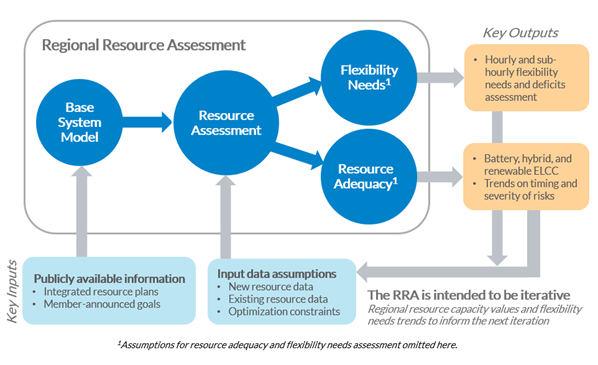The electricity industry is in the midst of a dramatic transformation. In the Midcontinent Independent System Operator (MISO) region, the generation fleet is shifting away from large fossil-fueled power plants that typically operated around the clock and toward smaller, weather-dependent renewables such as wind and solar generators. Adjacent industries are also putting pressure on the power sector. Electric vehicles are growing in popularity, and the residential and commercial building sectors are increasingly using electricity for heating and cooling purposes and often insisting their energy come from renewables. Meanwhile, these and other profound changes are taking place as extreme weather events are becoming more frequent and severe. These events can force resources offline, skew load forecasts, and cause a host of other problems across the region. Adapting to these changes requires greater visibility and farther-looking information about the future composition of the energy resources comprising the region’s bulk electricity system.

Aditya Jayam-Prabhakar
Many publicly announced utility plans and goals focus on increasing renewable energy and/or reducing carbon emissions. Utility plans and goals such as these are evolving rapidly and often change in response to customer needs and advancements in technology, making both local and regional planning more complex. For example, utilities and states may have neither full knowledge of nor visibility into how their neighbors plan to reduce their carbon emissions or otherwise modify their resource portfolios. Consequently, a state might make long-term plans for its energy infrastructure based on only limited information or even an incorrect understanding of a neighboring state’s plans. This could lead to a state becoming overly reliant on a single fuel or technology, which could make it vulnerable to extreme weather, fuel assurance or other reliability risks. Similarly, states and utilities that do not fully understand their neighbors’ plans might assume that they can utilize a regional market like MISO administers to compensate for any shortfalls they might experience, when in fact the market may not be able to provide an adequate supply of needed reliability services like energy or flexibility.

Jordan Bakke
What Will a Regional Resource Assessment Provide?
A regional resource assessment (RRA) is designed to address these and other challenges by compiling the numerous, disparate, and sometimes fluid public announcements on the region’s resources and putting them in a framework that is useful for utilities and state entities that plan generation resources in the region. For example, the RRA might identify a resource-planning trend in a part of the region that utilities and states elsewhere in the footprint may not otherwise see. Then the assessment looks for other potential gaps between the future generation fleet and the future needs of the bulk electricity system. For example, the assessment might indicate that 20 years in the future, when a particular utility carbon-reduction policy is fully implemented, part of the region may not have enough generation capable of supplying energy during times of low wind and solar generation. This long-range insight, not available prior to the RRA, provides the region, the utilities, and the states with the visibility and information necessary to anticipate and address potential resource gaps before they materialize.
The RRA produces a regional indicative view by modeling how the resource mix could evolve across a broad region made up of many different resource planning areas. The RRA models will generate an indicative view that will include details such as:
-
- The fuel and technology types of new resources that may be selected in addition to announced additions from utility resource plans
- The anticipated locations, sizes, and expected capacity factors of these new resources
- Time frames for when these new resources may be needed
This information will enable a regional operator like MISO, its members, and state regulators to assess whether enough resources with specific types of attributes — such as fast-ramping capability — will be available in the locations and at the times that they are needed. In so doing, the RRA will identify gaps between the future resource fleet and the expected needs of the electricity system going forward. Any such gaps will be reported at a region-wide level. As seen in Figure 1, the RRA combines the collective but disparate regional data and uses them in a way to create regional insights which can then iterate back to the resource planning decisions being made by the many different resource planning areas within the footprint. Figure 1: Regional Resource Assessment Overview
Figure 1: Regional Resource Assessment Overview
Source: MISO 2021 Regional Resource Assessment Report
How Will the Regional Resource Assessment Be Used?
The resource assessment, combined with the base system model, forms an indicative view of the resource portfolio for the MISO region through 2040. This indicative portfolio forms the basis for two types of analyses. The first is a resource adequacy analysis to consider whether the region will have sufficient generation capacity in 2040 to meet various reliability metrics. The second is a flexibility assessment to examine whether the region will have enough resources with fast-ramping capabilities to quickly inject energy into the system when weather-dependent renewables, such as wind and solar generation, are reduced or become unavailable.
MISO developed its first RRA in 2021 (see the detailed report here), which produced the following insights:
-
- Thermal resource energy declines over the next 20 years, even as installed capacity of natural gas generation in the MISO system could increase.
- Announced renewable and decarbonization goals will require nearly 140 GW of new generation, two-thirds of which must be renewable or other non-carbon-emitting resources, by 2040.
- Seasonal reliability contribution will become more important as the reliability risk shifts outside of summer season and net-load peak shifts to later in the day.
- The amount of energy provided by renewables surpasses “inflection points” at which certain additional complexities could emerge to cause difficulty in configuring and operating the grid in a reliable manner.
In addition to these general insights, the RRA produced a specific set of metrics such as seasonal capacity contributions and flexibility needs which can be used by individual resource planning areas within their models. These regionally produced metrics allow for an efficient feedback loop to be created between the highly detailed, but regionally limited local view, and the less detailed but regionally robust regional view. It will also give MISO members an opportunity to explain the details of complex initiatives that might otherwise be misinterpreted, such as decarbonization and renewable-energy goals.
MISO will continually improve the RRA to make it an increasingly valuable tool that utilities, states, and MISO itself can use to evaluate the evolution of the region’s electricity system. We look forward to engaging with other regions and thought partners on finding ways to navigate increasing regional complexity.
Aditya Jayam-Prabhakar and Jordan Bakke
MISO

Leave a Reply